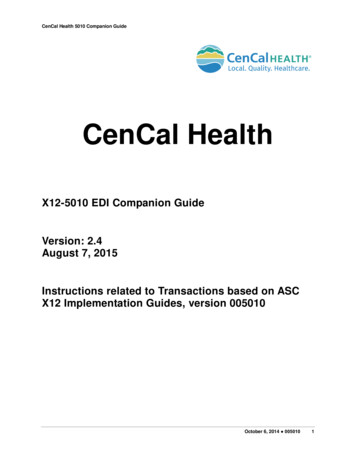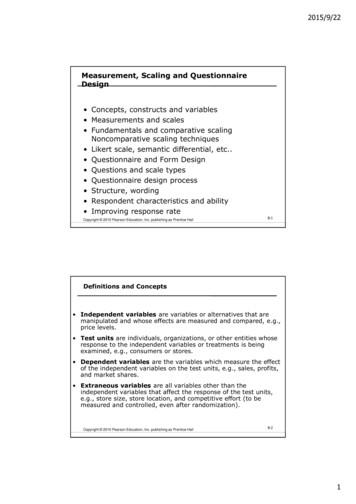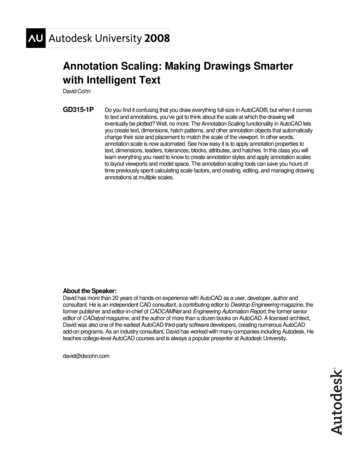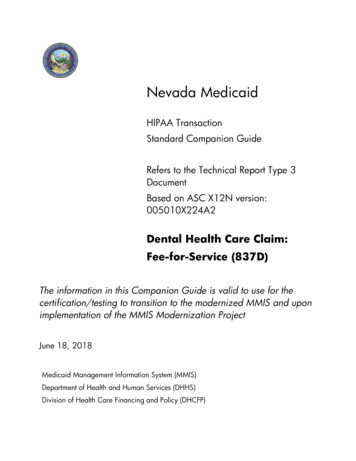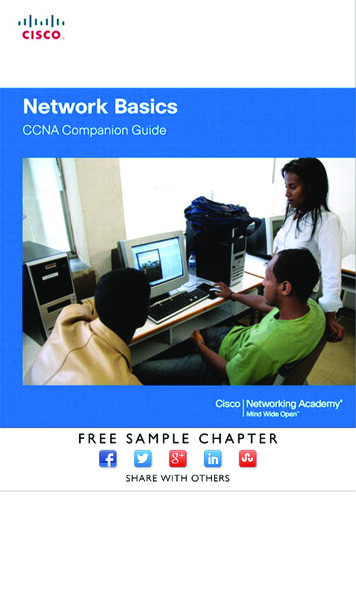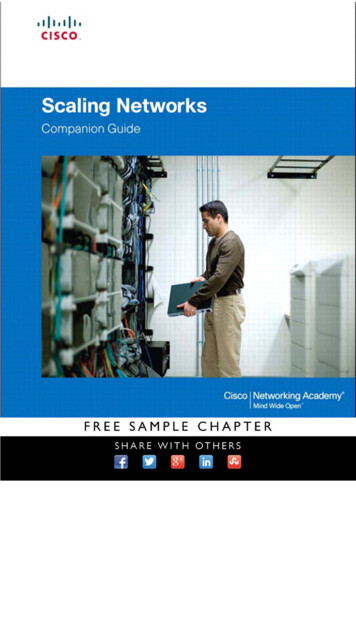
Transcription
Scaling NetworksCompanion GuideCisco Networking AcademyCisco Press800 East 96th StreetIndianapolis, Indiana 46240 USA
iiScaling Networks Companion GuideScaling Networks Companion GuideCisco Networking AcademyCopyright 2014 Cisco Systems, Inc.Published by:Cisco Press800 East 96th StreetIndianapolis, IN 46240 USAAll rights reserved. No part of this book may be reproduced or transmitted in any formor by any means, electronic or mechanical, including photocopying, recording, or byany information storage and retrieval system, without written permission from the publisher, except for the inclusion of brief quotations in a review.Printed in the United States of AmericaSecond Printing July 2014 with corrections August 2014Library of Congress Control Number: 2014932475ISBN-13: 978-1-58713-328-2ISBN-10: 1-58713-328-8Warning and DisclaimerThis book is designed to provide information about the Cisco Networking AcademyScaling Networks course. Every effort has been made to make this book as completeand as accurate as possible, but no warranty or fitness is implied.The information is provided on an “as is” basis. The authors, Cisco Press, and CiscoSystems, Inc. shall have neither liability nor responsibility to any person or entity withrespect to any loss or damages arising from the information contained in this book orfrom the use of the discs or programs that may accompany it.The opinions expressed in this book belong to the author and are not necessarily thoseof Cisco Systems, Inc.PublisherPaul BogerAssociate PublisherDave DusthimerBusiness OperationManager, Cisco PressJan CornelssenExecutive EditorMary Beth RayManaging EditorSandra SchroederDevelopment EditorEllie C. BruProject EditorMandie FrankCopy EditorJohn EdwardsTechnical EditorAubrey AdamsEditorial AssistantVanessa EvansDesignerMark ShirarCompositionBumpy DesignIndexerKen JohnsonProofreaderDebbie Williams
iiiTrademark AcknowledgmentsAll terms mentioned in this book that are known to be trademarks or service marks have been appropriately capitalized. Cisco Press or Cisco Systems, Inc., cannot attest to the accuracy of this information. Use of a term in thisbook should not be regarded as affecting the validity of any trademark or service mark.Special SalesFor information about buying this title in bulk quantities, or for special sales opportunities (which may includeelectronic versions; custom cover designs; and content particular to your business, training goals, marketingfocus, or branding interests), please contact our corporate sales department at corpsales@pearsoned.com or(800) 382-3419.For government sales inquiries, please contact governmentsales@pearsoned.com.For questions about sales outside the U.S., please contact international@pearsoned.com.At Cisco Press, our goal is to create in-depth technical books of the highest quality and value. Each book is craftedwith care and precision, undergoing rigorous development that involves the unique expertise of members from theprofessional technical community.Readers’ feedback is a natural continuation of this process. If you have any comments regarding how we couldimprove the quality of this book, or otherwise alter it to better suit your needs, you can contact us through email atfeedback@ciscopress.com. Please make sure to include the book title and ISBN in your message.We greatly appreciate your assistance.
ivScaling Networks Companion GuideAbout the Contributing AuthorAllan Johnson entered the academic world in 1999 after ten years as a businessowner/operator to dedicate his efforts to his passion for teaching. He holds both anMBA and an M.Ed. in Occupational Training and Development. He is an informationtechnology instructor at Del Mar College in Corpus Christi, Texas. In 2003, Allanbegan to commit much of his time and energy to the CCNA Instructional SupportTeam, providing services to Networking Academy instructors worldwide and creating training materials. He now works full-time for Cisco Networking Academy as alearning systems developer.
vContents at a GlanceIntroductionxxChapter 1Introduction to Scaling NetworksChapter 2LAN Redundancy49Chapter 3LAN Aggregation121Chapter 4Wireless LANsChapter 5Adjust and Troubleshoot Single-Area OSPFChapter 6Multiarea OSPFChapter 7EIGRPChapter 8EIGRP Advanced Configurations and TroubleshootingChapter 9IOS Images and LicensingAppendix AAnswers to “Check Your Understanding” Questions145237315361GlossaryIndex1569583453517555
viScaling Networks Companion GuideContentsIntroductionChapter 1xxIntroduction to Scaling NetworksObjectives1Key Terms1Introduction (1.0.1.1)13Implementing a Network Design (1.1)3Hierarchical Network Design (1.1.1) 3The Need to Scale the Network (1.1.1.1) 3Enterprise Business Devices (1.1.1.2) 5Hierarchical Network Design (1.1.1.3) 6Cisco Enterprise Architecture (1.1.1.4) 7Failure Domains (1.1.1.5) 9Expanding the Network (1.1.2) 11Design for Scalability (1.1.2.1) 11Planning for Redundancy (1.1.2.2) 12Increasing Bandwidth (1.1.2.3) 13Expanding the Access Layer (1.1.2.4) 14Fine-tuning Routing Protocols (1.1.2.5) 15Selecting Network Devices (1.2)18Switch Hardware (1.2.1) 18Switch Platforms (1.2.1.1) 18Port Density (1.2.1.2) 21Forwarding Rates (1.2.1.3) 22Power over Ethernet (1.2.1.4) 23Multilayer Switching (1.2.1.5) 25Router Hardware (1.2.2) 26Router Requirements (1.2.2.1) 26Cisco Routers (1.2.2.2) 28Router Hardware (1.2.2.3) 29Managing Devices (1.2.3) 30Managing IOS Files and Licensing (1.2.3.1) 30In-Band Versus Out-of-Band Management (1.2.3.2)Basic Router CLI Commands (1.2.3.3) 31Basic Router show Commands (1.2.3.4) 34Basic Switch CLI Commands (1.2.3.5) 39Basic Switch show Commands (1.2.3.6) 40Summary (1.3)4430
viiPractice45Class ActivitiesLabs4545Packet Tracer Activities45Check Your Understanding QuestionsChapter 2LAN RedundancyObjectives49Key Terms49Introduction (2.0.1.1)464951Spanning Tree Concepts (2.1)52Purpose of Spanning Tree (2.1.1) 52Redundancy at OSI Layers 1 and 2 (2.1.1.1) 52Issues with Layer 1 Redundancy: MAC DatabaseInstability (2.1.1.2) 54Issues with Layer 1 Redundancy: Broadcast Storms(2.1.1.3) 56Issues with Layer 1 Redundancy: Duplicate UnicastFrames (2.1.1.4) 57STP Operation (2.1.2) 59Spanning Tree Algorithm: Introduction (2.1.2.1) 59Spanning Tree Algorithm: Port Roles (2.1.2.2) 61Spanning Tree Algorithm: Root Bridge (2.1.2.3) 63Spanning Tree Algorithm: Path Cost (2.1.2.4) 64802.1D BPDU Frame Format (2.1.2.5) 67BPDU Propagation and Process (2.1.2.6) 68Extended System ID (2.1.2.7) 74Varieties of Spanning Tree Protocols (2.2)77Overview (2.2.1) 77List of Spanning Tree Protocols (2.2.1.1) 78Characteristics of the Spanning Tree Protocols (2.2.1.2) 79PVST (2.2.2) 80Overview of PVST (2.2.2.1) 80Port States and PVST Operation (2.2.2.2) 82Extended System ID and PVST Operation (2.2.2.3) 83Rapid PVST (2.2.3) 84Overview of Rapid PVST (2.2.3.1) 84RSTP BPDU (2.2.3.2) 86Edge Ports (2.2.3.3) 87Link Types (2.2.3.4) 88
viiiScaling Networks Companion GuideSpanning Tree Configuration (2.3)90PVST Configuration (2.3.1) 90Catalyst 2960 Default Configuration (2.3.1.1) 90Configuring and Verifying the Bridge ID (2.3.1.2) 91PortFast and BPDU Guard (2.3.1.3) 93PVST Load Balancing (2.3.1.4) 95Rapid PVST Configuration (2.3.2) 98Spanning Tree Mode (2.3.2.1) 98STP Configuration Issues (2.3.3) 101Analyzing the STP Topology (2.3.3.1) 101Expected Topology Versus Actual Topology (2.3.3.2) 102Overview of Spanning Tree Status (2.3.3.3) 102Spanning Tree Failure Consequences (2.3.3.4) 103Repairing a Spanning Tree Problem (2.3.3.5) 105First Hop Redundancy Protocols (2.4)105Concept of First Hop Redundancy Protocols (2.4.1) 106Default Gateway Limitations (2.4.1.1) 106Router Redundancy (2.4.1.2) 107Steps for Router Failover (2.4.1.3) 108Varieties of First Hop Redundancy Protocols (2.4.2) 109First Hop Redundancy Protocols (2.4.2.1) 109FHRP Verification (2.4.3) 110HSRP Verification (2.4.3.1) 110GLBP Verification (2.4.3.2) 112Syntax Checker — HSRP and GLBP (2.4.3.3) 114Summary (2.5)115Practice 116Class ActivitiesLabs116116Packet Tracer Activities116Check Your Understanding QuestionsChapter 3LAN AggregationObjectives121Key Terms121Introduction (3.0.1.1)117121122Link Aggregation Concepts (3.1)122Link Aggregation (3.1.1) 123Introduction to Link Aggregation (3.1.1.1) 123Advantages of EtherChannel (3.1.1.2) 124
ixEtherChannel Operation (3.1.2) 125Implementation Restrictions (3.1.2.1) 125Port Aggregation Protocol (3.1.2.2) 126Link Aggregation Control Protocol (3.1.2.3)Link Aggregation Configuration (3.2)128130Configuring EtherChannel (3.2.1) 130Configuration Guidelines (3.2.1.1) 130Configuring Interfaces (3.2.1.2) 131Verifying and Troubleshooting EtherChannel (3.2.2)Verifying EtherChannel (3.2.2.1) 133Troubleshooting EtherChannel (3.2.2.2) 135Summary (3.3)Practice139140Class ActivitiesLabs140140Packet Tracer Activities140Check Your Understanding QuestionsChapter 4133Wireless LANsObjectives145Key Terms145141145Introduction (4.0.1.1)147Wireless Concepts (4.1)147Introduction to Wireless (4.1.1) 147Supporting Mobility (4.1.1.1) 148Benefits of Wireless (4.1.1.2) 148Wireless Technologies (4.1.1.3) 149Radio Frequencies (4.1.1.4) 150802.11 Standards (4.1.1.5) 151Wi-Fi Certification (4.1.1.6) 153Comparing WLANs to a LAN (4.1.1.7) 154Components of WLANs (4.1.2) 156Wireless NICs (4.1.2.1) 156Wireless Home Router (4.1.2.2) 157Business Wireless Solutions (4.1.2.3) 159Wireless Access Points (4.1.2.4) 160Small Wireless Deployment Solutions (4.1.2.5)Large Wireless Deployment Solutions (4.1.2.6,4.1.2.7) 165Wireless Antennas (4.1.2.8) 168162
xScaling Networks Companion Guide802.11 WLAN Topologies (4.1.3) 170802.11 Wireless Topology Modes (4.1.3.1)Ad Hoc Mode (4.1.3.2) 170Infrastructure Mode (4.1.3.3) 171Wireless LAN Operations (4.2)170173802.11 Frame Structure (4.2.1) 173Wireless 802.11 Frame (4.2.1.1) 173Frame Control Field (4.2.1.2) 175Wireless Frame Type (4.2.1.3) 177Management Frames (4.2.1.4) 177Control Frames (4.2.1.5) 180Wireless Operation (4.2.2) 181Carrier Sense Multiple Access with Collision Avoidance(4.2.2.1) 181Wireless Clients and Access Point Association(4.2.2.2) 183Association Parameters (4.2.2.3) 183Discovering APs (4.2.2.4) 187Authentication (4.2.2.5) 189Channel Management (4.2.3) 191Frequency Channel Saturation (4.2.3.1) 191Selecting Channels (4.2.3.2) 193Planning a WLAN Deployment (4.2.3.3) 196Wireless LAN Security (4.3)198WLAN Threats (4.3.1) 198Securing Wireless (4.3.1.1) 198DoS Attack (4.3.1.2) 199Management Frame DoS Attacks (4.3.1.3) 200Rogue Access Points (4.3.1.4) 202Man-in-the-Middle Attack (4.3.1.5) 203Securing WLANs (4.3.2) 205Wireless Security Overview (4.3.2.1) 205Shared Key Authentication Methods (4.3.2.2) 206Encryption Methods (4.3.2.3) 208Authenticating a Home User (4.3.2.4) 208Authentication in the Enterprise (4.3.2.5) 210Wireless LAN Configuration (4.4)211Configure a Wireless Router (4.4.1) 211Configuring a Wireless Router (4.4.1.1) 211Setting Up and Installing Initial Linksys EA6500(4.4.1.2) 213Configuring the Linksys Smart Wi-Fi Home Page(4.4.1.3) 217
xiSmart Wi-Fi Settings (4.4.1.4) 218Smart Wi-Fi Tools (4.4.1.5) 220Backing Up a Configuration (4.4.1.6) 224Configuring Wireless Clients (4.4.2) 225Connecting Wireless Clients (4.4.2.1) 225Troubleshoot WLAN Issues (4.4.3) 226Troubleshooting Approaches (4.4.3.1) 226Wireless Client Not Connecting (4.4.3.2) 227Troubleshooting When the Network Is Slow (4.4.3.3)Updating Firmware (4.4.3.4) 230Summary (4.5)Practice232233Class ActivitiesLabs233233Packet Tracer Activities234Check Your Understanding QuestionsChapter 5234Adjust and Troubleshoot Single-Area OSPFObjectives237Key Terms237Introduction (5.0.1.1)237238Advanced Single-Area OSPF Configurations (5.1)238Routing in the Distribution and Core Layers (5.1.1) 238Routing Versus Switching (5.1.1.1) 238Static Routing (5.1.1.2) 239Dynamic Routing Protocols (5.1.1.3) 240Open Shortest Path First (5.1.1.4) 241Configuring Single-Area OSPF (5.1.1.5) 242Verifying Single-Area OSPF (5.1.1.6) 244Configuring Single-Area OSPFv3 (5.1.1.7) 247Verifying Single-Area OSPFv3 (5.1.1.8) 249OSPF in Multiaccess Networks (5.1.2) 251OSPF Network Types (5.1.2.1) 251Challenges in Multiaccess Networks (5.1.2.2) 253OSPF Designated Router (5.1.2.3) 255Verifying DR/BDR Roles (5.1.2.4) 256Verifying DR/BDR Adjacencies (5.1.2.5) 259Default DR/BDR Election Process (5.1.2.6) 261DR/BDR Election Process (5.1.2.7) 262The OSPF Priority (5.1.2.8) 265Changing the OSPF Priority (5.1.2.9) 265229
xiiScaling Networks Companion GuideDefault Route Propagation (5.1.3) 268Propagating a Default Static Route in OSPFv2(5.1.3.1) 268Verifying the Propagated Default Route (5.1.3.2) 269Propagating a Default Static Route in OSPFv3(5.1.3.3) 271Verifying the Propagated IPv6 Default Route (5.1.3.4) 272Fine-Tuning OSPF Interfaces (5.1.4) 273OSPF Hello and Dead Intervals (5.1.4.1) 273Modifying OSPFv2 Intervals (5.1.4.2) 275Modifying OSPFv3 Intervals (5.1.4.3) 277Secure OSPF (5.1.5) 279Routers Are Targets (5.1.5.1) 279Secure Routing Updates (5.1.5.2) 280MD5 Authentication (5.1.5.3) 281Configuring OSPF MD5 Authentication (5.1.5.4) 282OSPF MD5 Authentication Example (5.1.5.5) 283Verifying OSPF MD5 Authentication (5.1.5.6) 284Troubleshooting Single-Area OSPF Implementations (5.2)286Components of Troubleshooting Single-Area OSPF (5.2.1) 286Overview (5.2.1.1) 286OSPF States (5.2.1.2) 287OSPF Troubleshooting Commands (5.2.1.3) 288Components of Troubleshooting OSPF (5.2.1.4) 292Troubleshoot Single-Area OSPFv2 Routing Issues (5.2.2) 293Troubleshooting Neighbor Issues (5.2.2.1) 293Troubleshooting OSPF Routing Table Issues (5.2.2.2) 297Troubleshoot Single-Area OSPFv3 Routing Issues (5.2.3) 299OSPFv3 Troubleshooting Commands (5.2.3.1) 299Troubleshooting OSPFv3 (5.2.3.2) 302Summary (5.3)306Practice 308Class ActivitiesLabs308308Packet Tracer Activities308Check Your Understanding QuestionsChapter 6Multiarea OSPFObjectives315Key Terms315315309
xiiiIntroduction (6.0.1.1)316Multiarea OSPF Operation (6.1)316Why Multiarea OSPF? (6.1.1) 316Single-Area OSPF (6.1.1.1) 316Multiarea OSPF (6.1.1.2) 317OSPF Two-Layer Area Hierarchy (6.1.1.3) 319Types of OSPF Routers (6.1.1.4) 320Multiarea OSPF LSA Operation (6.1.2) 321OSPF LSA Types (6.1.2.1) 321OSPF LSA Type 1 (6.1.2.2) 322OSPF LSA Type 2 (6.1.2.3) 323OSPF LSA Type 3 (6.1.2.4) 324OSPF LSA Type 4 (6.1.2.5) 325OSPF LSA Type 5 (6.1.2.6) 326OSPF Routing Table and Types of Routes (6.1.3) 326OSPF Routing Table Entries (6.1.3.1) 327OSPF Route Calculation (6.1.3.2) 328Configuring Multiarea OSPF (6.2)329Configuring Multiarea OSPFv2 and OSPFv3 (6.2.1) 329Implementing Multiarea OSPF (6.2.1.1) 329Configuring Multiarea OSPF (6.2.1.2) 330Configuring Multiarea OSPFv3 (6.2.1.3) 332OSPF Route Summarization (6.2.2) 334OSPF Route Summarization (6.2.2.1) 334Interarea and External Route Summarization (6.2.2.2) 336Interarea Route Summarization (6.2.2.3) 338Calculating the Summary Route (6.2.2.4) 339Configuring Interarea Route Summarization (6.2.2.5) 340Verifying Multiarea OSPF (6.2.3) 342Verifying Multiarea OSPF (6.2.3.1) 342Verify General Multiarea OSPF Settings (6.2.3.2) 343Verify the OSPF Routes (6.2.3.3) 345Verify the Multiarea OSPF LSDB (6.2.3.4) 346Verify Multiarea OSPFv3 (6.2.3.5) 349Summary (6.3)Practice354356Class ActivitiesLabs356356Packet Tracer Activities356Check Your Understanding Questions356
xivScaling Networks Companion GuideChapter 7EIGRP361Objectives361Key Terms361Introduction (7.0.1.1)363Characteristics of EIGRP (7.1)363Basic Features of EIGRP (7.1.1) 363Features of EIGRP (7.1.1.1) 364Protocol-Dependent Modules (7.1.1.2) 365Reliable Transport Protocol (7.1.1.3) 367Authentication (7.1.1.4) 368Types of EIGRP Packets (7.1.2) 368EIGRP Packet Types (7.1.2.1) 368EIGRP Hello Packets (7.1.2.2) 370EIGRP Update and Acknowledgment Packets (7.1.2.3)EIGRP Query and Reply Packets (7.1.2.4) 372EIGRP Messages (7.1.3) 373Encapsulating EIGRP Messages (7.1.3.1) 373EIGRP Packet Header and TLV (7.1.3.2) 374Configuring EIGRP for IPv4 (7.2)370377Configuring EIGRP with IPv4 (7.2.1) 377EIGRP Network Topology (7.2.1.1) 377Autonomous System Numbers (7.2.1.2) 379The Router EIGRP Command (7.2.1.3) 381EIGRP Router ID (7.2.1.4) 382Configuring the EIGRP Router ID (7.2.1.5) 384The network Command (7.2.1.6) 385The network Command and Wildcard Mask (7.2.1.7) 387Passive Interface (7.2.1.8) 389Verifying EIGRP with IPv4 (7.2.2) 392Verifying EIGRP: Examining Neighbors (7.2.2.1) 392Verifying EIGRP: show ip protocols Command(7.2.2.2) 393Verifying EIGRP: Examine the IPv4 Routing Table(7.2.2.3) 396Operation of EIGRP (7.3)399EIGRP Initial Route Discovery (7.3.1) 399EIGRP Neighbor Adjacency (7.3.1.1) 399EIGRP Topology Table (7.3.1.2) 400EIGRP Convergence (7.3.1.3) 401
xvMetrics (7.3.2) 402EIGRP Composite Metric (7.3.2.1) 402Examining Interface Values (7.3.2.2) 405Bandwidth Metric (7.3.2.3) 406Delay Metric (7.3.2.4) 408How to Calculate the EIGRP Metric (7.3.2.5) 409Calculating the EIGRP Metric (7.3.2.6) 410DUAL and the Topology Table (7.3.3) 413DUAL Concepts (7.3.3.1) 413Introduction to DUAL (7.3.3.2) 413Successor and Feasible Distance (7.3.3.3) 414Feasible Successors, Feasibility Condition, and ReportedDistance (7.3.3.4) 415Topology Table: show ip eigrp topology Command(7.3.3.5) 417Topology Table: show ip eigrp topology Command (Cont.)(7.3.3.6) 418Topology Table: No Feasible Successor (7.3.3.7) 420DUAL and Convergence (7.3.4) 422DUAL Finite State Machine (FSM) (7.3.4.1) 423DUAL: Feasible Successor (7.3.4.2) 424DUAL: No Feasible Successor (7.3.4.3) 426Configuring EIGRP for IPv6 (7.4)429EIGRP for IPv4 Versus IPv6 (7.4.1) 429EIGRP for IPv6 (7.4.1.1) 429Comparing EIGRP for IPv4 and IPv6 (7.4.1.2) 430IPv6 Link-Local Addresses (7.4.1.3) 432Configuring EIGRP for IPv6 (7.4.2) 432EIGRP for IPv6 Network Topology (7.4.2.1) 432Configuring IPv6 Link-Local Addresses (7.4.2.2) 434Configuring the EIGRP for IPv6 Routing Process(7.4.2.3) 436The ipv6 eigrp Interface Command (7.4.2.4) 437Verifying EIGRP for IPv6 (7.4.3) 440Verifying EIGRP for IPv6: Examining Neighbors(7.4.3.1) 440Verifying EIGRP for IPv6: show ipv6 protocols Command(7.4.3.2) 441Verifying EIGRP for IPv6: Examine the IPv6 Routing Table(7.4.3.3) 442Summary (7.5)445
xviScaling Networks Companion GuidePractice 446Class ActivitiesLabs446447Packet Tracer Activities447Check Your Understanding QuestionsChapter 8447EIGRP Advanced Configurations and TroubleshootingObjectives453Key Terms453Introduction (8.0.1.1)453454Advanced EIGRP Configurations (8.1)454Automatic Summarization (8.1.1) 455Network Topology (8.1.1.1) 455EIGRP Automatic Summarization (8.1.1.2) 457Configuring EIGRP Automatic Summarization(8.1.1.3) 459Verifying Auto-Summary: show ip protocols (8.1.1.4) 460Verifying Auto-Summary: Topology Table (8.1.1.5) 462Verifying Auto-Summary: Routing Table (8.1.1.6) 464Summary Route (8.1.1.7) 465Summary Route (Cont.) (8.1.1.8) 466Manual Summarization (8.1.2) 468Manual Summary Routes (8.1.2.1) 468Configuring EIGRP Manual Summary Routes(8.1.2.2) 470Verifying Manual Summary Routes (8.1.2.3) 471EIGRP for IPv6: Manual Summary Routes (8.1.2.4) 472Default Route Propagation (8.1.3) 474Propagating a Default Static Route (8.1.3.1) 474Verifying the Propagated Default Route (8.1.3.2) 476EIGRP for IPv6: Default Route (8.1.3.3) 477Fine-Tuning EIGRP Interfaces (8.1.4) 478EIGRP Bandwidth Utilization (8.1.4.1) 479Hello and Hold Timers (8.1.4.2) 480Load-Balancing IPv4 (8.1.4.3) 482Load-Balancing IPv6 (8.1.4.4) 484Secure EIGRP (8.1.5) 486Routing Protocol Authentication Overview (8.1.5.1) 486Configuring EIGRP with MD5 Authentication(8.1.5.2) 488
xviiEIGRP Authentication Example (8.1.5.3)Verify Authentication (8.1.5.4) 491Troubleshoot EIGRP (8.2)489493Components of Troubleshooting EIGRP (8.2.1) 493Basic EIGRP Troubleshooting Commands (8.2.1.1)Components (8.2.1.2) 495Troubleshoot EIGRP Neighbor Issues (8.2.2) 496Layer 3 Connectivity (8.2.2.1) 496EIGRP Parameters (8.2.2.2) 497EIGRP Interfaces (8.2.2.3) 498Troubleshoot EIGRP Routing Table Issues (8.2.3) 500Passive Interface (8.2.3.1) 500Missing Network Statement (8.2.3.2) 502Automatic Summarization (8.2.3.3) 504Summary (8.3)Practice509511Class ActivitiesLabs511511Packet Tracer Activities511Check Your Understanding QuestionsChapter 9493IOS Images and LicensingObjectives517Key Terms517Introduction (9.0.1.1)512517518Managing IOS System Files (9.1)518Naming Conventions (9.1.1) 519Cisco IOS Software Release Families and Trains(9.1.1.1) 519Cisco IOS Release 12.4 Mainline and T Trains(9.1.1.2) 519Cisco IOS Release 12.4 Mainline and T Numbering(9.1.1.3) 521Cisco IOS Release 12.4 System Image Packaging(9.1.1.4) 522Cisco IOS Release 15.0 M and T Trains (9.1.1.5) 523Cisco IOS Release 15 Train Numbering (9.1.1.6) 525IOS Release 15 System Image Packaging (9.1.1.7) 526IOS Image Filenames (9.1.1.8) 528
xviiiScaling Networks Companion GuideManaging Cisco IOS Images (9.1.2) 531TFTP Servers as a Backup Location (9.1.2.1) 531Creating a Cisco IOS Image Backup (9.1.2.2) 531Copying a Cisco IOS Image (9.1.2.3) 533Boot System (9.1.2.4) 534IOS Licensing (9.2)536Software Licensing (9.2.1) 536Licensing Overview (9.2.1.1) 536Licensing Process (9.2.1.2) 538Step 1. Purchase the Software Package or Feature toInstall (9.2.1.3) 539Step 2. Obtain a License (9.2.1.4) 539Step 3. Install the License (9.2.1.5) 541License Verification and Management (9.2.2) 542License Verification (9.2.2.1) 542Activate an Evaluation Right-To-Use License (9.2.2.2)Back Up the License (9.2.2.3) 545Uninstall the License (9.2.2.4) 546Summary (9.3)544548Practice 551Class Activities551Packet Tracer Activities551Check Your Understanding QuestionsAppendix A551Answers to the “Check Your Understanding” QuestionsGlossaryIndex569583555
xixIcons Used in This BookRouterRoute/SwitchProcessor with andwithout orkgroupSwitchCisco ASA5500CiscoCallManagerAccessPointCisco 5500FamilyFile/ApplicationServerLaptopIP PhoneHome PhoneLine: EthernetWireless ConnectivitySyntax ConventionsThe conventions used to present command syntax in this book are the same conventions used in the IOS Command Reference. The Command Reference describesthese conventions as follows:QBoldface indicates commands and keywords that are entered literally as shown.In actual configuration examples and output (not general command syntax),boldface indicates commands that are manually input by the user (such as ashow command).QItalics indicate arguments for which you supply actual values.QVertical bars ( ) separate alternative, mutually exclusive elements.QSquare brackets ([ ]) indicate an optional element.QBraces ({ }) indicate a required choice.QBraces within brackets ([{ }]) indicate a required choice within an optional element.
xxScaling Networks Companion GuideIntroductionScaling Networks Companion Guide is the official supplemental textbook for theCisco Networking Academy Scaling Networks course. Cisco Networking Academyis a comprehensive program that delivers information technology skills to studentsaround the world. The curriculum emphasizes real-world practical application, whileproviding opportunities for you to gain the skills and hands-on experience neededto design, install, operate, and maintain networks in small- to medium-sized businesses, as well as enterprise and service provider environments.As a textbook, this book provides a ready reference to explain the same networkingconcepts, technologies, protocols, and devices as the online curriculum. This bookemphasizes key topics, terms, and activities and provides some alternate explanations and examples as compared with the course. You can use the online curriculumas directed by your instructor and then use this Companion Guide’s study tools tohelp solidify your understanding of all the topics.Who Should Read This BookThis book is intended for students enrolled in the Cisco Networking Academy Scaling Networks course. The book, as well as the course, is designed as an introductionto data network technology for those pursuing careers as network professionals aswell as those who need only an introduction to network technology for professionalgrowth. Topics are presented concisely, starting with the most fundamental conceptsand progressing to a comprehensive understanding of network communication. Thecontent of this text provides the foundation for additional Cisco Networking Academy courses, and preparation for the CCNA Routing and Switching certification.Book FeaturesThe educational features of this book focus on supporting topic coverage, readability, and practice of the course material to facilitate your full understanding of thecourse material.Topic CoverageThe following features give you a thorough overview of the topics covered in eachchapter so that you can make constructive use of your study time:
xxiQObjectives: Listed at the beginning of each chapter, the objectives reference thecore concepts covered in the chapter. The objectives match the objectives statedin the corresponding chapters of the online curriculum. However, the questionformat in the Companion Guide encourages you to think about finding theanswers as you read the chapter.QNotes: These are short sidebars that point out interesting facts, timesavingmethods, and important safety issues.QChapter summaries: At the end of each chapter is a summary of the chapter’skey concepts. It provides a synopsis of the chapter and serves as a study aid.QPractice: At the end of each chapter, there is a full list of all the Labs, ClassActivities, and Packet Tracer Activities to refer back to for study time.ReadabilityThe following features have been updated to assist your understanding of the networking vocabulary:QKey terms: Each chapter begins with a list of key terms, along with a pagenumber reference from inside the chapter. The terms are listed in the order inwhich they are explained in the chapter. This handy reference allows you to finda term, flip to the page where the term appears, and see the term used in context. The Glossary defines all the key terms.QGlossary: This book contains an all-new Glossary with almost 200 terms.PracticePractice makes perfect. This new Companion Guide offers you ample opportunitiesto put what you learn into practice. You will find the following features valuableand effective in reinforcing the instruction that you receive:QCheck Your Understanding questions and answer key: Updated review questions are presented at the end of each chapter as a self-assessment tool. Thesequestions match the style of questions that you see in the online course.Appendix A, “Answers to ‘Check Your Understanding’ Questions,” provides ananswer key to all the questions and includes an explanation of each answer.
xxiiScaling Networks Companion GuideQLabs and activities: Throughout each chapter, you will be directed back to theonline course to take advantage of the activities created to reinforce concepts.In addition, at the end of each chapter, there is a Practice section that collects alist of all the labs and activities to provide practice with the topics introduced inthis chapter. The labs and class activities are available in the companion ScalingNetworks Lab Manual (ISBN 978-1-58713-325-1). The Packet Tracer ActivitiesPKA files are found in the online course.QPage references to online course: After headings, you will see, for example,(1.1.2.3). This number refers to the page number in the online course so that youcan easily jump to that spot online to view a video, practice an activity, performa lab, or review a topic.Packet TracerActivityVideoLab ManualThe supplementary book Scaling Networks Lab Manual, by Cisco Press(ISBN 978-1-58713-325-1), contains all the labs and class activities from the course.Practice and Study GuideAdditional Study Guide exercises, activities, and scenarios are available in the CCNARouting and Switching Practice and Study Guide (ISBN 978-1-58713-344-2), byAllan Johnson. The Practice and Study Guide coordinates with the recommendedcurriculum sequence and follows the course outlines for Scaling Networks andConnecting Networks.
xxiiiAbout Packet Tracer Software and ActivitiesPacket TracerActivityInterspersed throughout the chapters you’ll find many activities to work with theCisco Packet Tracer tool. Packet Tracer allows you to create networks, visualize howpackets flow in the network, and use basic testing tools to determine whether thenetwork would work. When you see this icon, you can use Packet Tracer with thelisted file to perform a task suggested in this book. The activity files are available inthe course. Packet Tracer software is available only through the Cisco NetworkingAcademy website. Ask your instructor for access to Packet Tracer.How This Book Is OrganizedThis book corresponds closely to the Cisco Networking Academy Scaling Networkscourse and is divided into nine chapters, one appendix, and a glossary of key terms: Q Chapter 1, “Introduction to Scaling Networks”: Introduces strategies that canbe used to systematically design a highly functional network, such as the hierarchical network design model, the Cisco Enterprise Architecture, and appropriatedevice selections. Q Chapter 2, “LAN Redundancy”: Focuses on the protocols used to manageredundancy (STP and FHRP) as well as some of the potential redundancy problems and their symptoms. Q Chapter 3, “LAN Aggregation”: Describes EtherChannel, the methods used tocreate an EtherChannel, and the EtherChannel protocols PAgP and LACP. Theconfiguration, verification, and troubleshooting of EtherChannel are discussed. Q Chapter 4, “Wireless LANs”: Covers WLAN technology, components, security,planning, implementation, and troubleshooting. The types of network attacks towhich wireless networks are particularly susceptible are discussed.
xxivScaling Networks Companion Guide Q Chapter 5, “Adjust and Troubleshoot Single-Area OSPF”: Examines themethods for modifying the default operation of OSPF, inclu
GLBP Verification (2.4.3.2) 112 Syntax Checker — HSRP and GLBP (2.4.3.3) 114 Summary (2.5) 115 Practice 116 Class Activities 116 Labs 116 Packet Tracer Activities 116 Check Your Understanding Questions 117 Chapter 3 LAN Aggregation 121 Objectives 121 Key Terms 121 Introduction (3.0.1.1) 122 Link Aggregation Concepts (3.1) 122


